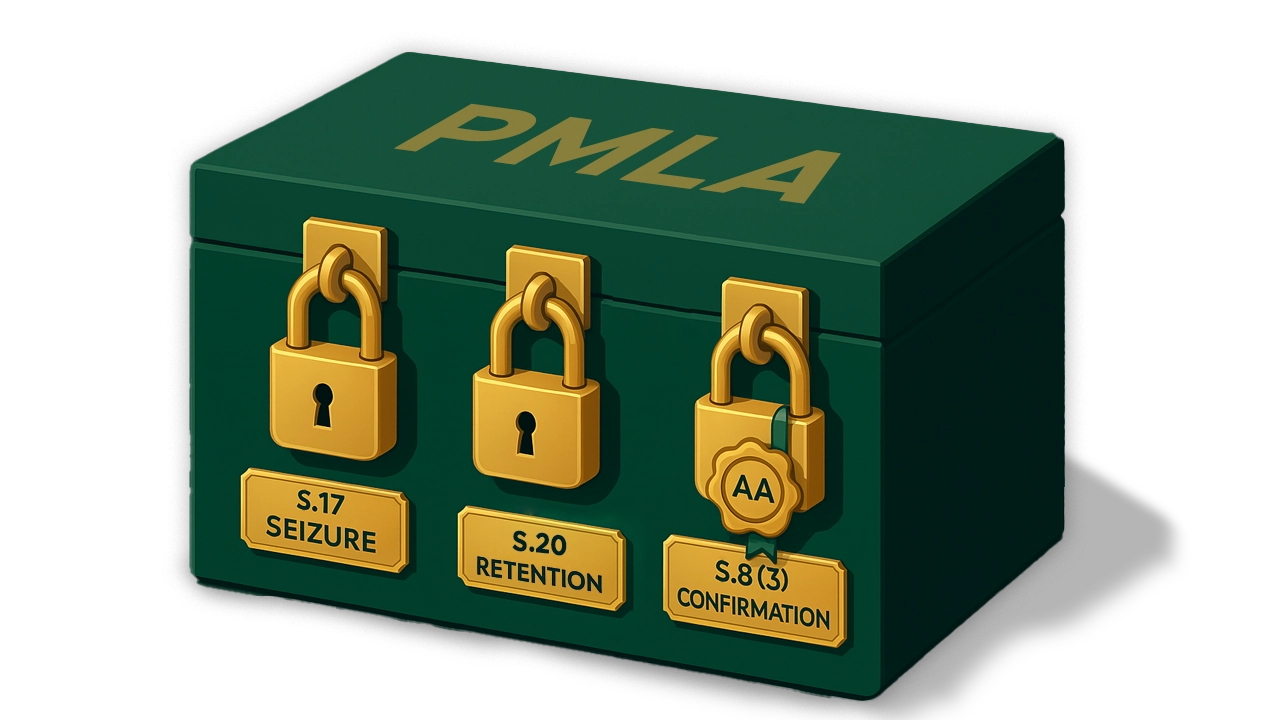Introduction
Imagine a government agency, armed with vast powers to combat financial crime, seizing a person’s property—be it cash, documents, or digital devices—under the suspicion of its link to illegal activities. This is the scene set by the Prevention of Money Laundering Act (PMLA1). While the power of search and seizure is a necessary tool for law enforcement to investigate and prosecute, it is a formidable one that directly impacts a person’s right to property, a constitutional right under Article 300A. The delicate balance between this state power and the fundamental rights of citizens is often a point of contention, especially when the seized property is held for extended periods without a clear, legally sound basis. This very predicament forms the core of a recent landmark judgment by the Delhi High Court.
In the case of Directorate Of Enforcement Through Assistant Director Delhi Vs. Rajesh Kumar Agarwal2, a division bench comprising Justice Subramonium Prasad and Justice Harish Vaidyanathan Shankar delivered a meticulously crafted judgment that sided with the accused. The court’s decision isn’t just a technical win; it’s a profound affirmation of the principle that state power, particularly when it encroaches upon an individual’s property rights, must be exercised with scrupulous care and within the confines of the law.
The court held that the retention of seized property without strict adherence to the procedural safeguards laid out in the PMLA would be a grave violation of the law’s very essence. This article will delve into the detailed jurisprudence upon which this impeccable judgment is based, exploring how the court’s reasoning reinforces the delicate balance between effective law enforcement and the fundamental rights of citizens.
Navigating the complex landscape of the Prevention of Money Laundering Act (PMLA) requires a precise understanding of its procedural safeguards, particularly concerning the seizure and retention of property. The core legal debate revolves around the delicate “balance between the state’s power to combat financial crime and an individual’s constitutional right to property under Article 300A”. This recent judicial pronouncement has meticulously dissected this very issue, clarifying the distinct roles of various sections of the Act. The central question is: can property seized by an investigating authority be retained indefinitely without strict adherence to the law’s procedural mandates?
The statutory scheme, as laid out in the PMLA, creates a two-step process for search, seizure, and subsequent retention. The first step involves the initial act of search and seizure under Section 17. This section empowers an authorized officer, based on a “reason to believe,” to seize property or records. Following this, the law requires the officer to immediately forward the reasons for seizure along with the relevant material to the AA3. Crucially, this initial act of seizure is distinct from the authority to retain the property. For a property to be retained, the law mandates a separate and specific procedure.
This is where Section 20 comes into play, a provision that governs the retention of seized property. It requires the authorized officer to pass a formal, reasoned order for the retention of the property for a period not exceeding 180 days. This order must be based on an independent “reason to believe” that the property is required for adjudication under Section 8. It is this retention order that is then forwarded to the AA. The AA’s role, as defined by Section 8(3), is to “confirm” the retention of the property—not to pass the initial retention order itself.
The power to confirm is not equivalent to the power to order retention; one cannot exist without the other. This procedural layering acts as a critical safeguard against arbitrary deprivation of property. The law further clarifies that the AA’s power to permit continued retention only arises after the initial 180-day period has expired. This distinction ensures that the authority to retain property for an extended period is subject to judicial scrutiny and is not an automatic consequence of the initial seizure.
The judiciary’s interpretation of this statutory scheme is rooted in the fundamental principle that an action “bad in its inception” cannot be cured by a subsequent validation. This legal doctrine, affirmed in landmark Supreme Court cases like State of Orissa v. Mamata Mohanty4 and Ritesh Tewari v. State of U.P5., underscores that any deviation from express procedural mandates strikes at the very root of the legal order. The right to property, while no longer a fundamental right, remains a constitutional right that cannot be usurped without the authority of law. As reiterated in Laxman Lal v. State of Rajasthan6 and OPTO Circuits (India) Ltd. v. Axis Bank7, procedural compliance is not a mere formality but a mandatory requirement, particularly when individual rights are at stake. By reinforcing these principles, the legal reasoning serves as a bulwark against the potential for an investigating agency to bypass the built-in checks and balances designed to ensure fairness and accountability. The law, in its intricate design, demands reasoned adjudication at every step, making it clear that a mechanical or superficial approach is legally unsustainable.
Conclusion
This meticulous judgment by the Delhi High Court is not merely an isolated legal victory; it is a profound reaffirmation of the fundamental principles of due process and the rule of law. By striking down the notion that procedural safeguards are optional or can be bypassed, the court has sent an unequivocal message that state power, no matter how essential for law enforcement, must be exercised within the strict confines of the law. The ruling establishes a crucial check on the unbridled power of investigating agencies, ensuring that citizens are not subjected to the arbitrary deprivation of their property. It firmly anchors the PMLA within a framework of accountability, reminding us that the fight against financial crime cannot come at the cost of sacrificing constitutional and legal rights.
Looking ahead, this judgment sets a powerful precedent that will undoubtedly shape future jurisprudence. It compels investigating authorities to be more scrupulous and methodical in their actions, ensuring that every step, from the initial seizure to the final retention, is meticulously documented and legally justified. The ruling is a clear directive that the burden of proof is not just on the accused but also on the state to demonstrate that its actions are both necessary and lawful. This will likely lead to a greater emphasis on reasoned orders, transparent processes, and timely adjudication, thereby reducing the potential for abuse and enhancing public trust in the legal system. It provides a legal roadmap for individuals to challenge a potentially unlawful retention of their property, empowering them to hold the state accountable.
The true test of this judgment, however, lies in its practical implementation. Will investigating agencies adapt their procedures to fully comply with this ruling? Will lower courts and tribunals consistently apply this principle, or will new challenges emerge? The decision leaves open a critical question for the future: How can the legal system ensure that the spirit of these procedural safeguards is upheld even as technology and financial crimes evolve? As we move forward, the vigilance of the judiciary and the adherence of law enforcement agencies to these high standards will be paramount. This judgment, in essence, is not an end but a new beginning—a call to action for all stakeholders to re-commit to the principles of fairness, proportionality, and the unwavering protection of individual rights.
Citations
- Prevention of Money Laundering Act Prevention of Money Laundering Act, 2002
- Directorate Of Enforcement Through Assistant Director Delhi Vs. Rajesh Kumar Agarwal Misc. Appeal (PMLA) 03 of 2023
- Adjudicating Authority
- State of Orissa v. Mamta Mohanty (2011) 3 SCC 436
- Ritesh Tewari v. State of U.P(2010) 10 SCC 677
- Laxman Lal v. State of Rajasthan (2013) 3 SCC 764
- OPTO Circuits (India) Ltd. v. Axis Bank (2021) 6 SCC 707
Expositor(s): Adv. Anuja Pandit






